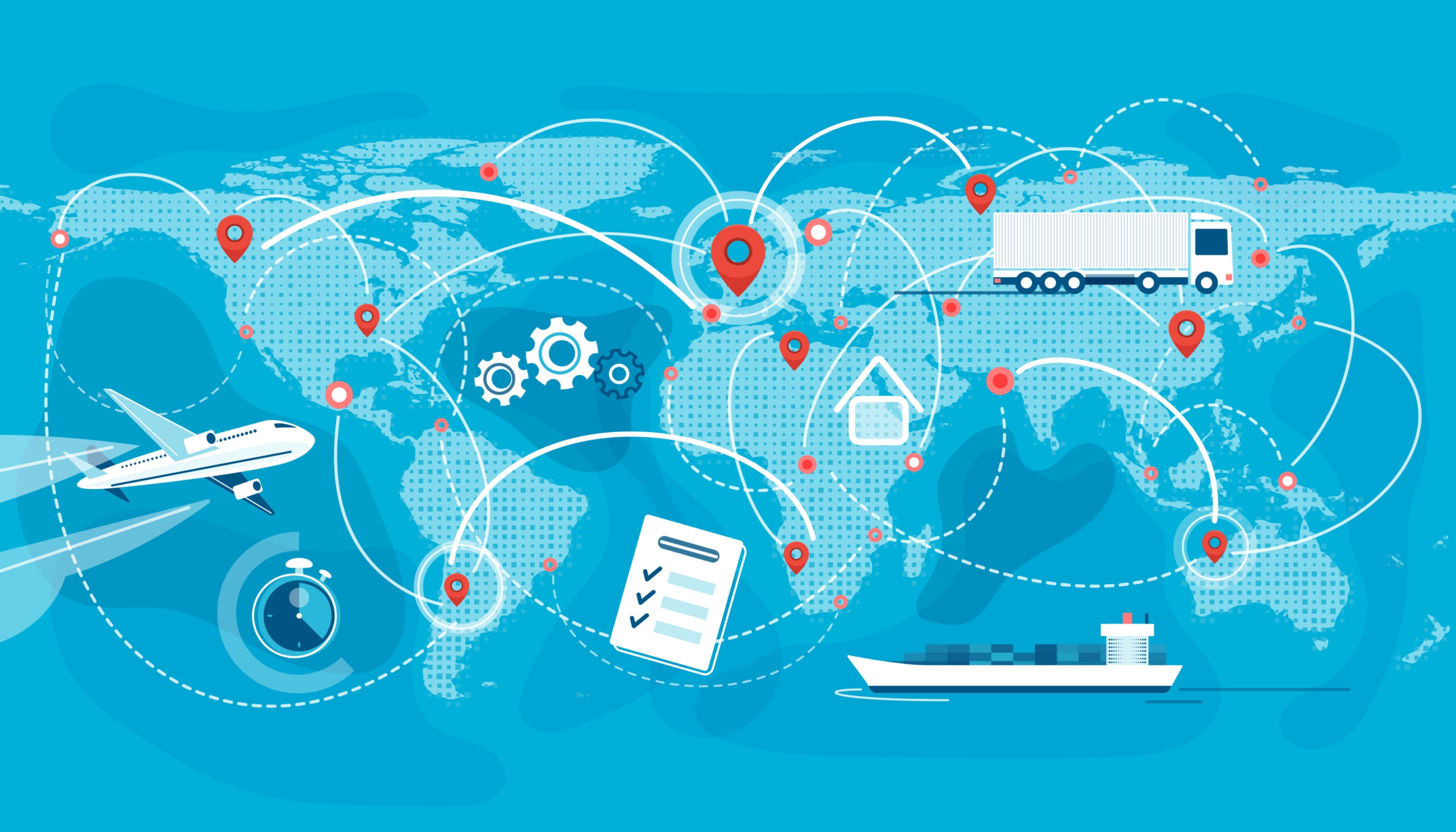How to Increase Supply Chain Visibility and Reduce Costs
In today’s fast-paced and interconnected business landscape, supply chain visibility has become critical in achieving efficiency, cost-effectiveness, and customer satisfaction.
As a business owner researching logistics options, you understand the importance of optimizing your supply chain operations.
In this comprehensive guide, we will delve into the concept of supply chain visibility and how it can lead to reduced logistics costs.
What is Supply Chain Visibility?
Supply chain visibility is the ability of a business to have real-time insight and transparency into its entire supply chain operations, from sourcing raw materials to delivering finished products to end customers.
It involves tracking and monitoring the movement of goods, information, and funds across various supply chain stages.
How it Works
Supply chain visibility works through a combination of technology, collaboration, and predictive analytics:
Utilizes Technologies: Modern supply chain visibility utilizes technologies such as RFID (Radio-Frequency Identification), GPS (Global Positioning System), and advanced software systems for real-time tracking and data integration.
Collaboration: Collaborating with supply chain partners—suppliers, manufacturers, and distributors—is crucial for achieving end-to-end supply chain visibility. Sharing real-time information ensures that all stakeholders have access to the same data, fostering coordination and transparency.
Predictive Analytics: Implementing predictive analytics tools is a strategic move to anticipate potential issues and demand fluctuations in your supply chain. By leveraging historical data, market trends, and various predictive models, you can gain valuable insights into future scenarios.
Why it Reduces Costs
Now that we understand how supply chain visibility works and the various mechanisms behind it, let’s explore how it directly impacts your bottom line:
Optimized Decision-Making:
- Inventory Management: With real-time inventory data, you can optimize stock levels, reduce carrying costs, and minimize the risk of stockouts or overstock situations.
- Production Scheduling: Timely insights into supplier delays or changes in demand allow you to adjust production schedules, reducing idle time and production costs.
- Transportation Routes: Visibility enables you to choose the most cost-effective transportation routes and modes, saving on shipping expenses.
Efficient Resource Utilization:
- Resource Allocation: With accurate data on demand and production, you can allocate resources efficiently, avoiding unnecessary expenditures and waste.
- Labour Costs: Automation and streamlined processes reduce the need for excessive manual labour, saving on labour costs.
Improved Planning and Forecasting:
- Inventory Holding Costs: By accurately forecasting demand, you can optimize inventory levels and reduce holding costs.
- Customer Service Costs: Minimizing order fulfillment delays and discrepancies leads to fewer customer service inquiries and complaints.
Proactive Issue Resolution:
- Emergency Shipping Costs: Anticipating and resolving issues before they escalate eliminates the need for costly emergency shipping and overtime labour.
Enhanced Collaboration and Negotiation:
- Negotiation Power: Improved collaboration with suppliers and distributors can lead to better negotiation terms, further reducing procurement costs.
- Reduced Disputes: Transparent data sharing reduces disputes and costly legal actions.
Customer Satisfaction and Loyalty:
- Fewer Returns: Accurate delivery estimates and fewer disruptions result in fewer product returns, saving on return-related processing and shipping costs.
- Customer Retention: Satisfied customers are more likely to become loyal, repeat customers, reducing the cost of acquiring new customers.
How to Increase Supply Chain Visibility
Now that we’ve established the importance of supply chain visibility and its significant impact on cost reduction let’s dive into practical strategies to enhance visibility, along with detailed implementation steps, cost-saving implications, and additional benefits for your business.
1. Invest in Advanced Tracking Technologies
Implementing advanced tracking technologies, such as RFID, GPS, and IoT devices, is a foundational step in achieving supply chain visibility.
These technologies provide real-time tracking and monitoring capabilities, allowing you to trace the movement of goods with precision.
Implementation: To harness the full potential of these technologies, integrate them seamlessly into your supply chain operations. For RFID, attach tags to individual products or pallets, and deploy readers at key points in your supply chain.
For GPS, equip your vehicles or containers with tracking devices. IoT devices can be strategically placed in storage facilities, transportation vehicles, and production areas to collect data on various environmental conditions and product statuses.
Cost Savings: The adoption of advanced tracking technologies offers several cost-saving benefits:
- Reduced Shipment Loss: RFID and GPS technology significantly reduce the risk of lost or stolen shipments, minimizing financial losses associated with missing products.
- Minimized Delays: Real-time location data from GPS helps optimize transportation routes and schedules, reducing delays and associated costs.
- Enhanced Asset Utilization: IoT devices can monitor the condition of assets, ensuring they are used efficiently and maintained properly, prolonging their lifespan and reducing replacement costs.
- Improved Security: RFID and IoT devices enhance security by providing alerts for unauthorized access or tampering, minimizing theft and vandalism.
2. Integrate Data from Supply Chain Partners
Collaborating with supply chain partners—suppliers, manufacturers, and distributors—is crucial for achieving end-to-end supply chain visibility.
Sharing real-time information ensures that all stakeholders have access to the same data, fostering coordination and transparency.
Implementation: Implement integrated software systems that connect data sources along the supply chain.
This can involve adopting robust Enterprise Resource Planning (ERP) systems, Supply Chain Management (SCM) software, or even Application Programming Interfaces (APIs) that facilitate data sharing between different systems used by partners.
Cost Savings: The integration of data from supply chain partners yields numerous cost-saving advantages:
- Efficient Inventory Management: Access to real-time inventory data from suppliers and distributors helps prevent overstocking and stockouts, reducing storage costs and lost sales opportunities.
- Streamlined Procurement: Real-time supplier data allows for better procurement planning, enabling you to negotiate favourable terms, minimize rush orders, and reduce procurement costs.
- Optimized Production: Collaboration with manufacturers helps synchronize production schedules, reducing production inefficiencies and costly downtime.
3. Utilize Predictive Analytics
Implementing predictive analytics tools is a strategic move to anticipate potential issues and demand fluctuations in your supply chain.
You can gain valuable insights into future scenarios by leveraging historical data, market trends, and various predictive models.
Implementation: Integrate predictive analytics software into your supply chain management system. Ensure your team is trained to use these tools effectively to extract actionable insights.
Cost Savings: Predictive analytics offer substantial cost-saving opportunities:
- Reduced Emergency Expenses: By identifying potential disruptions or bottlenecks in advance, you can take proactive measures to prevent emergencies that often result in costly expedited shipping or production downtime.
- Optimized Inventory: Predictive analytics assist in maintaining optimal inventory levels, reducing holding costs and minimizing the need for costly rush orders.
- Resource Allocation: Precise demand forecasting enables you to allocate resources efficiently, minimizing wastage and unnecessary expenses.
4. Adopt Cloud-Based Supply Chain Platforms
Transitioning to cloud-based supply chain platforms is a modernization step that provides real-time access to supply chain data from anywhere.
These platforms offer scalability, security, and collaboration features that can significantly improve your supply chain visibility.
Implementation: Migrate your data and supply chain operations to cloud-based solutions. Collaborate with experts to ensure a seamless transition and integration with your existing systems.
Cost Savings: Adopting cloud-based supply chain platforms delivers several cost-related benefits:
- Infrastructure Cost Reduction: Cloud-based solutions eliminate the need for extensive on-premises infrastructure, reducing hardware and maintenance costs.
- Scalability: Pay-as-you-go models ensure you only pay for the resources you use, avoiding overprovisioning and wasted expenses.
- Enhanced Collaboration: Real-time access and collaboration tools improve communication among supply chain stakeholders, reducing misunderstandings and costly errors.
5. Implement Customer-Facing Visibility
Giving customers real-time updates on their orders and deliveries is essential for building trust and satisfaction. Transparency throughout the order fulfillment process enhances customer relationships.
Implementation: Integrate customer-facing portals, mobile apps, or communication channels that enable customers to track their orders, receive notifications, and access relevant information.
Cost Savings: Customer-facing visibility leads to cost savings in several ways:
- Reduced Customer Support Costs: Customers can self-serve and track their orders, reducing the volume of inquiries and support requests.
- Fewer Returns: Accurate delivery information and fewer disruptions result in fewer product returns, saving on return-related processing and shipping costs.
- Enhanced Loyalty: Satisfied customers are more likely to become repeat customers, reducing the cost of acquiring new customers.
Conclusion
In conclusion, increasing supply chain visibility is not just a strategic choice; it is a necessity in today’s competitive business environment.
The benefits, including optimized decision-making, efficient resource utilization, and improved planning, can lead to significant cost savings while enhancing customer satisfaction and loyalty.
At PiVAL, we understand the importance of supply chain visibility, and our services are designed to help you achieve it.
By leveraging our expertise and advanced technologies, you can streamline your logistics processes, reduce costs, and gain a competitive edge in your industry.
We’re able to track the progress of your goods, from the moment they leave your dock to final delivery confirmation, in real-time, on your desktop and on your mobile devices – including 3G transportation management systems (TMS) and comprehensive analytical reporting.
If you’re ready to take the next step in improving your supply chain visibility and reducing logistics costs, contact us today to learn more about our solutions and how we can support your logistics needs.
Stay Up-To-Date
There's always something new from PiVAL



Leave a Reply